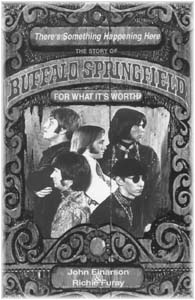![[Metroactive Books]](/books/gifs/books468.gif)
![[Metroactive Books]](/books/gifs/books468.gif)
[ Books Index | Metro | Metroactive Central | Archives ]
For What It's Worth
 Nowadays, They Can't Even Sing: A new book details the rise and fall of Buffalo Springfield.
The Buffalo Springfield once challenged the Byrds and the Beatles--but something happened there By Nicky Baxter MOST HISTORIES of pop music position the Byrds at the center of the mid-1960s folk-rock revolution--and rightly so. Roger McGuinn's nasally tuneful singing and chiming 12-string Richenbacker guitar have influenced everyone from Tom Petty to R.E.M. Often obscured by the Byrdmania, however, is the fact that the Buffalo Springfield was at least as talented and just as influential. Along with McGuinn's group, the Buffalo Springfield inaugurated the era of supergroups. There's Something Happening Here: The Story of Buffalo Springfield: For What It's Worth offers compelling evidence that had the group managed to survive, it might have blown right past the Byrds as the seminal American rock band. John Einarson and former Buffalo Springfield bandmember Richie Furay do an exemplary job prying beneath the layers of myth and mystique to get at what made the group succeed in the first place, as well as detailing the myriad factors that contributed to its lamentably premature demise. Furay's insider's view contributes immensely to this highly readable account's claim to legitimacy. Furay, who sang and played rhythm guitar with the group, would appear to be the perfect choice to set the record straight. While the epic battle of wills between co-founders Stephen Stills and Neil Young continually threatened to capsize the Springfield, Furay found himself in the awkward position of peacemaker, a thankless and ultimately futile job. Informative yet refreshingly free of pedantry, the book brings back to life the buckskinned '60s without resorting to starry-eyed nostalgia-hawking. There's Something Happening Here traverses plenty of ground, commencing with the rise of folk music and its subsequent intersection with--and eventual usurpation by--rock. Along with Bob Dylan, the Beatles and the Byrds, Buffalo Springfield hastened that musical coup d'etat. The Buffalo Springfield had everything going for it. The members' keening four-part harmonies, though less polished, rivaled those of the Beatles and the Byrds. Moreover, Stills and Young were superb tunesmiths. Stills' "Bluebird" and Young's "Mr. Soul" rank among rock's finest moments. Songs like "Kind Woman" demonstrated that Furay himself was a capable writer as well. In bassist Bruce Palmer and drummer Dewey Martin, the band boasted one of pop's most versatile rhythm units. Last but not least was Buffalo Springfield's catholicity. Tangy pop, wistful country, folk, R&B and rock were all afforded equal standing in the Springfield arsenal. ALTHOUGH it is not surprising that he casts himself in a benign light, Furay has no hidden agenda--well, maybe a small one. After all, at the group's inception he was the pretty-boy frontman. Stills, the de facto Buffalo boss, was content to share guitar duties with Young and pen well-crafted vehicles for Furay. Young, a moody, often enigmatic character from the start, was even more reluctant to assume center stage, convinced that his strangled warbling was an acquired taste. Both Young and Stills confirm that Furay was a charismatic figure in performance. It wouldn't be long before Furay got unceremoniously ushered from the spotlight. A wildly successful six-week stint at the Whiskey-A-Go Go in L.A. in 1966 proved, ironically, to be the group's undoing. That first taste of fame quickly went to Stills' already swelled head. Besieged by hordes of groupies, dope and inexplicable insecurities, Young, too, went off the deep end. The troubles were intensified in the studio, where inept managers serving as producers failed to capture the group's potential on tape. The group's debut album, Buffalo Springfield, was brilliant despite subpar production. Stills' "Sit Down I Think I Love You" was arguably the most commercial offering, but it was not released as a single, which was a big mistake. When Young's brilliant but obtuse "Nowadays Clancy Can't Even Sang" sank without a trace, the Springfield's already fragile morale plummeted. Shortly thereafter, Stills' "For What It's Worth" supplied the hit the band so desperately sought but at incalculable cost to its ever-tenuous internal balance. Although the song was claimed as the anthem of a generation, according to Einarson and Furay, it was anathema to Young, who seemed threatened by his partner's suddenly skyrocketing popularity. This is not the only instance in which Young is painted as being every bit as egotistical as Stills. In fact, perhaps for the first time, Young is portrayed as a willful and sometimes petty-minded individual, a gifted artist whose single-minded quest for success bordered on the ruthless. Furay and Einarson go so far as to imply that Young used the band as a stepping stone to launch his own solo career. While Stills openly craved the trappings of pop stardom, Young's desire for recognition was manifested more passively; hence his repeated departures from the band. Ultimately, it was the lethal combination of inflated egos, mismanagement, ineffectual marketing and soured expectations that conspired to rip asunder America's answer to the Beatles. What with all the various reunions and album reissues from the era, There's Something Happening Here is a timely reminder that its brief existence notwithstanding, the Buffalo Springfield ranks among pop music's most prodigiously gifted groups, symbolizing rock's promise as well as its predilection for autodestruction.
There's Something Happening Here: The Story of Buffalo Springfield: For What It's Worth by John Einarson and Richie Furay; Quarry Music Books; 310 pages; $15.95 paper. [ Metro | Metroactive Central | Archives ]
| ||||||||||||||||||||||||||||||
Copyright © Metro Publishing Inc. Maintained by Boulevards New Media.